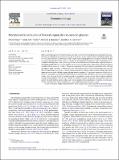Files in this item
Morphometric evolution of Everest region debris-covered glaciers
Item metadata
| dc.contributor.author | King, Owen | |
| dc.contributor.author | Turner, Andy G.D. | |
| dc.contributor.author | Quincey, Duncan J. | |
| dc.contributor.author | Carrivick, Jonathan L. | |
| dc.date.accessioned | 2020-12-07T15:57:32Z | |
| dc.date.available | 2020-12-07T15:57:32Z | |
| dc.date.issued | 2020-12-15 | |
| dc.identifier | 270230963 | |
| dc.identifier | dafbc25e-742c-4420-95f3-c0bc5fb37f2c | |
| dc.identifier | 85091234079 | |
| dc.identifier | 000591680500005 | |
| dc.identifier.citation | King , O , Turner , A G D , Quincey , D J & Carrivick , J L 2020 , ' Morphometric evolution of Everest region debris-covered glaciers ' , Geomorphology , vol. 371 , 107422 . https://doi.org/10.1016/j.geomorph.2020.107422 | en |
| dc.identifier.issn | 0169-555X | |
| dc.identifier.other | RIS: urn:76CD5B8DE85A6FDF53346A68496ACDA4 | |
| dc.identifier.uri | https://hdl.handle.net/10023/21086 | |
| dc.description | OK was a recipient of a NERC SPHERES DTP PhD studentship (grant award NE/L002574/1). The Natural Environment Research Council Geophysical Equipment Facility (NERC GEF) is thanked for loaning Global Navigation Satellite Systems receivers and technical assistance under loan numbers 1050, 1058 and 1065. | en |
| dc.description.abstract | Debris-covered glaciers in the central Himalaya have now experienced several decades of sustained ice loss, manifested predominantly in glacier surface lowering. In particular, glacier surfaces of low longitudinal gradient and low ice surface velocity have developed locally complex surface topographies and undergone profound changes in supraglacial hydrology. In this study we examine the development of complex ice surface topography across six debris-covered glaciers in the Everest region over the last four decades via a new metric of glacier surface relief applied to Digital Elevation Models (DEMs). We focus in on Khumbu Glacier, and use fine spatial and temporal resolution DEMs covering a period of 28 months to quantify the contemporary contribution of ice cliff and supraglacial pond expansion to overall mass loss from stagnant areas of ice. On the broader scale, we find three common long-term changes in glacier surface topography, (1) glacier-wide expansion of high relief topography in response to ice cliff and supraglacial pond network evolution, (2) up-glacier expansion of high local relief zones that may be caused by differential sub-debris melt beneath thin debris, and (3) increase in glacier surface relief proximal to glacier termini caused by supraglacial stream incision where linked proglacial-supraglacial hydrological networks exist. Overall, we contend that these topographic measurements will be important for understanding glacier surface water storage and also the energy balance of a debris-covered glacier surface, both of which could exacerbate future ice loss and downstream meltwater supply. | |
| dc.format.extent | 15 | |
| dc.format.extent | 10104659 | |
| dc.language.iso | eng | |
| dc.relation.ispartof | Geomorphology | en |
| dc.subject | Debris-covered glacier | en |
| dc.subject | Glacier metrics | en |
| dc.subject | Structure from motion | en |
| dc.subject | Glacier surface topography | en |
| dc.subject | Glacier surface relief | en |
| dc.subject | G Geography (General) | en |
| dc.subject | 3rd-DAS | en |
| dc.subject.lcc | G1 | en |
| dc.title | Morphometric evolution of Everest region debris-covered glaciers | en |
| dc.type | Journal article | en |
| dc.contributor.institution | University of St Andrews. School of Geography & Sustainable Development | en |
| dc.contributor.institution | University of St Andrews. Environmental Change Research Group | en |
| dc.identifier.doi | 10.1016/j.geomorph.2020.107422 | |
| dc.description.status | Peer reviewed | en |
| dc.identifier.url | https://www.sciencedirect.com/science/article/pii/S0169555X20303950#s0115 | en |
This item appears in the following Collection(s)
Items in the St Andrews Research Repository are protected by copyright, with all rights reserved, unless otherwise indicated.

